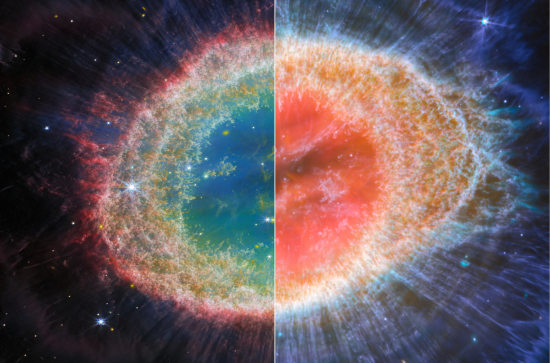
The NASA/ESA/CSA James Webb Space Telescope has released a new image of the well-known Ring Nebula with unprecedented detail. The new images show intricate details of structures and features, allowing scientists to understand both their chemistry and how they formed.

Formed by a star throwing off its outer layers as it runs out of fuel, the Ring Nebula is an archetypal planetary nebula, and is relatively close to Earth at roughly 2,500 light-years away, making it an important object for scientists.
Commenting on the images, Dr Patrick Kavanagh, Department of Experimental Physics, said: “There has never been mid-infrared images of the Ring Nebula like this before. The exquisite detail reveals previously unknown features in the molecular halo that tell us this dying star’s nebula was likely shaped by an unseen companion star. There simply has not been a telescope capable of seeing these features until JWST.”
The new images provide unprecedented spatial resolution that show the intricate details of the filament structure of the inner ring (left) taken by NIRCam (Near-InfraRed Camera) and the concentric features of the outer regions of the nebulae’s ring (right) taken by MIRI (Mid-InfraRed Instrument). For context, it is the equivalent of distinguishing the details of a soccer ball at a distance of 550km.
The images also provide insight on what the structures comprise and how they evolved. The images show some 20,000 dense globules in the nebula, which are rich in molecular hydrogen. In contrast, the inner region shows very hot gas. The main shell contains a thin ring of enhanced emission from carbon-based molecules known as polycyclic aromatic hydrocarbons (PAHs).
Approximately ten concentric arcs are located just beyond the outer edge of the main ring. The arcs are thought to originate from the interaction of the central star with a low-mass companion orbiting at a distance comparable to that between the Earth and the dwarf planet Pluto. In this way, nebulae like the Ring Nebula reveal a kind of astronomical archaeology, as astronomers study the nebula to learn about the star that created it.
The colourful main ring is composed of gas thrown off by a dying star at the centre of the nebula. This star is on its way to becoming a white dwarf — a very small, dense, and hot body that is the final evolutionary stage for a star like the Sun.
The Ring Nebula is one of the most notable objects in our skies. It was discovered in 1779 by astronomers Antoine Darquier de Pellepoix and Charles Messier, and was added to the Messier Catalogue. Both astronomers stumbled upon the nebula when trying to follow the path of a comet through the constellation of Lyra, passing very close to the Ring Nebula.
These observations were completed as part of the James Webb Space Telescope observing programme GO 1558. Webb is an international partnership between NASA, ESA and the Canadian Space Agency (CSA).
The full paper, JWST observations of the Ring Nebula (NGC 6720): I. Imaging of the rings, globules, and arcs, will be published in the Monthly Notices of the Royal Astronomical Society, is available to read here.
